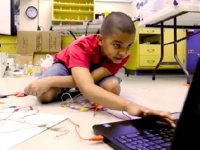Design Challenge: DIY Assistive Game Controllers
Here are four of many possible ways for transforming standard video games into assistive technology tools that students of any ability can enjoy.
Video gaming is a social activity that can empower participants. According to the Entertainment Software Association (ESA), "59% of Americans play video games" -- many of whom are children (PDF, 925KB). Those with physical disabilities, however, may find it nearly impossible to participate alongside their peers. Console controllers -- like those included with Xbox, PlayStation, and Wii gaming systems -- can have over one dozen buttons, often requiring two hands to operate.
The AbleGamers Foundation is a nonprofit organization that "aims to improve the overall quality of life for those with disabilities through the power of video games." To that end, it published Includification, a game accessibility guideline to help developers extend accessibility for all. For more, watch this YouTube video about AbleGamers' mission:
Simple Switch Interfaces
A switch simply turns an electrical signal on or off (e.g., a light switch, the right-click button on a mouse, the spacebar on a keyboard). MaKey MaKey is an easy-to-use kit that can serve as a switch interface. Costing about $50, MaKey MaKey is built on an Arduino circuit board and includes a USB cable, alligator clips, and additional wires. Almost anything that carries an electrical current -- pencil graphite, bananas, modeling clay -- can become part of the circuit. When the USB is plugged in, the computer's keyboard interface becomes shared with MaKey MaKey. There are assistive guides posted on its web page, in which a computer’s keys are remapped (rerouted) to best work with a person's needs.
Design Challenges
More often than not, a teacher or paraprofessional is responsible for adapting a device to fit a person's need. Below are sample challenges that can be met using MaKey MaKey as a do-it-yourself (DIY) assistive game controller:
1. Mini-Keyboard Challenge
AbleGamers with muscular dystrophy can find movement across a keyboard to be difficult. However, there are ways to move with greater precision. For example, a track ball interface is often used instead of a mouse -- the ball can be rolled without moving or stretching one's arms. The challenge is to use MaKey MaKey to move game keys very close together. A solution might be creating a dedicated mini-keyboard for the WASD keys (common in PC games: W = up, A = left, S = down, D = right), along with the arrow keys, spacebar (in some games this is jump or shoot), and enter button. The user must be able to operate the controller with one idle hand.
2. Macro-Keyboard Challenge
AbleGamers with cerebral palsy can find fine motor activity to be nearly impossible. The challenge is to use MaKey MaKey to spread out the WASD keys, along with the arrow keys, spacebar, and enter buttons. Modeling clay on a desk can be used to spread out the input keys.
3. Head Mobility Challenge
Some AbleGamers can move only their heads. The challenge is to design a game controller using head movement to take the place of arrow keys. It can work well with dancing games created on Scratch.
4. Simple Switch Challenge
Some AbleGamers have very restricted mobility. A hand chop, shoulder shrug, or even a tongue move can be used to interact with one-button games. Try Flabby Physics, playable with just the spacebar.
I attempted to create a directional head movement interface using MaKey MaKey. Moving my head could, theoretically, take the place of arrow keys on my laptop. I could touch my left shoulder with my head to turn left in a game world. First I had a brainstorming session -- paper towel rolls, hats, shirt collars, and other apparatus were considered as materials. I discovered that the most flexible tool for the head movement interface was a small necklace made from pipe cleaners. Wearing the contraption proved uncomfortable and awkward. Upon observing this, my wife suggested that I use a travel neck pillow. This accomplished two things: an object to prop up the pipe cleaner ring and something to provide added comfort. Of course, I was testing my own design. To be most effective, try your prototype with a person of need.
Teaching Students to be Designers
Design thinking is considered to be a desirable 21st century or "soft" skill. Bringing in students as designers can make the process even more inclusive. Working in teams can create a learning environment in which solutions emerge. A jigsaw cooperative structure would work effectively in the testing phases. Students would then have the opportunity to watch their prototypes used through someone else's eyes. (Herein lies another challenge -- something obvious to the designer may not be obvious to the user.) Testers can move from group to group. No one should test the same design twice. If you only have one kit, then groups can work in a station, out of view from the rest of the class. The goal is for other students to not see the prototyped design.
MaKey MaKey is a tool that can make video games accessible for AbleGamers. Take the systemic rather than technocentric approach to integrating this tool. The technology that you're introducing should not be the sole focus of the activity. Keep in mind that you're using MaKey MaKey to remap a keyboard that will enable students of all abilities to play.
